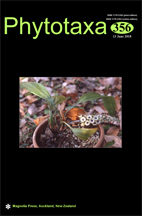Abstract
The genus Nitella is the most species-rich within the Charales. Brazilian studies on the genus are relatively scarce and consist of floristic surveys, lacking modern and more precise information. This investigation applied scanning electron microscopy to analyze the oospore wall and molecular data associated with traditional morphological characters to analyze forty-two populations of Nitella from the midwest and southeast regions of Brazil. Forty-two new sequences of rbcL, twelve of ITS1 and twenty-three of ITS2 were generated for the five species recognized in this study: Nitella acuminata A. Braun ex Wallman, Nitella axillaris A. Braun, Nitella elegans B. P. Pal, Nitella flagellifera J. Groves & G. O. Allen and Nitella microcarpa A. Braun.. Phylogenetic analyses of sequences of these three markers were congruent in that they grouped our species with others from different countries to form five clades. Our results on ultrastrucure of the oospore wall were consistent with previous studies for the same species from other regions of the world. The data reinforced the conclusion that the use of ornamentation of oospore wall may be extremely useful for the construction of a natural system for Characeae at section level. Molecular evidence, reinforced by morphological data, for the Brazilian material analyzed suggests that Nitella subglomerata A. Braun and Nitella gollmeriana A. Braun could be synonymys of Nitella acuminata; and Nitella axilliformis K. Imahori appears to be the same as Nitella axillaris. However, no formal proposition was made considering that type specimens were not analyzed and these observations were based on a relatively small number of samples strictly from Brazil. We showed that even among geographically distant populations, such as from other continents, of some Nitella species, the degree of identity among DNA sequences was high.

